Patras–Greece’s third largest city–was also an important one in Classical and Roman times. But in the hills overlooking the city, there is also evidence of an older legacy of the area going back to Mycenaean times. The most important of these prehistoric sites is Voudeni, which appears to have been inhabited from 1500 to 1000 BCE. Today it is preserved in an archaeological park featuring both the remains of an ancient settlement as well as the necroplolis where the inhabitants buried their dead.
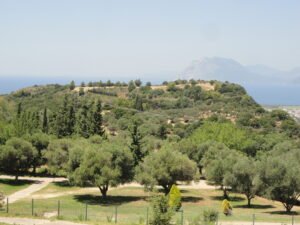
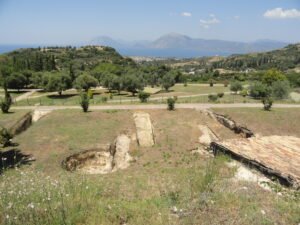
The hill on which the necropolis is located by far the most impressive of the two parts of the site today. There are dozens of chamber tombs of various sizes and shapes, many of which are open for visitors to enter and explore.

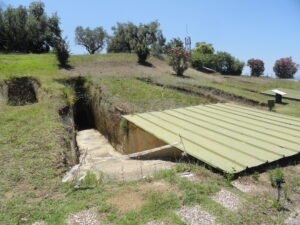
Some of the tombs are quite large and obviously must have been used by elites. One example is Tomb 4, in which the remains of six individuals were found.

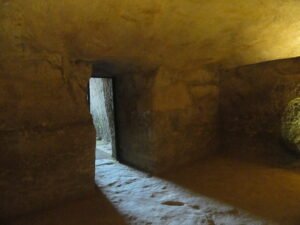
Despite being one of the medium-sized tombs, the most memorable of them is probably Tomb 5, which features 6 skeletons left in situ. These were from the primary burial, but there were also 5 other individuals found in a secondary burial pit off to the left side. As the first accessible tomb on the visitors’ path, it does well in setting the tone of the visit by reminding one that this isn’t just an archaeological site but also a cemetery.

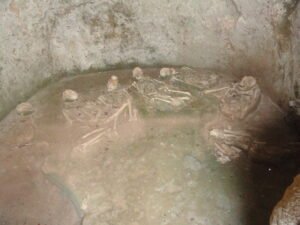
The settlement itself was on another hill (Bortzi) just a kilometer away from the necropolis. Its position was obviously strategic, as the hilltop has a splendid view over the Gulf of Patras as well as the entrance to the Gulf of Corinth. Such a wide view would also have given the inhabitants the ability to see and signal other Mycenaean sites in the region. Unfortunately, it is today little more than a rockpile spread out over the hilltop.
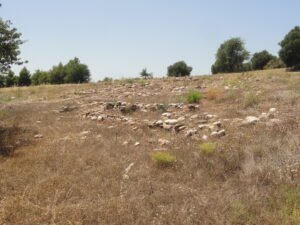

Behind the settlement, at the western edge of the hilltop, visitors can see the extent of the view of the surrounding area that the inhabitants had. They also get a nice view of the city of Patras as well as the Rion-Antirion Bridge, which now connects the western Peloponnese with the rest of the Greek mainland to the north.
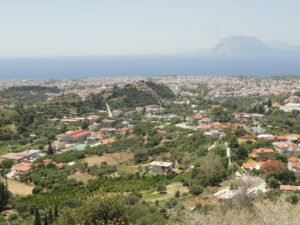
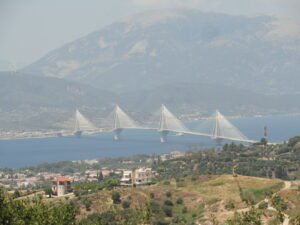
There are a few more rockpiles covered with protected roofs which can be found in the lower terrain between the settlement and the necropolis.
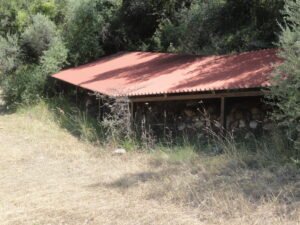
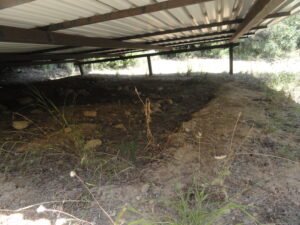
Some artifacts from Voudeni (such as the ceramic ware pictured below, dating to the final decades of the site) can be viewed at the Archaeological Museum of Patras, which is an 8-km drive from the site.
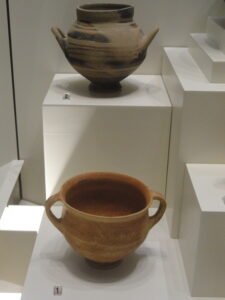
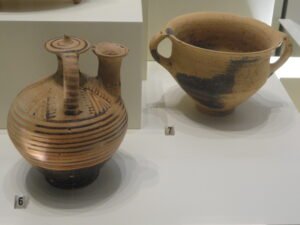
One particularly interesting find from the cemetery at Voudeni on display at the museum in Patras is a 13th-century-BCE teracotta larnax which was used for holding the body of one of the deceased. The marine life motif is clearly in the style of the Minoan civilization of Crete.
 Tips for the Visitor
Tips for the Visitor
The site is an 8-km drive from central Patras. A taxi ride will cost around 10 euro. The site is open until 15:30 most days (check the opening days and hours before you visit) and entrance cost 3 euro at the time of our visit. The ticket office and entrance are accessed by way of the 180-meter foot path which leads from the site’s parking lot, located southeast of the site.
The necropolis and the settlement are part of the same archaeological park and are connected by two paths–one which is more direct and another slightly longer one which takes visitors down near one of the streams that would have provided water for the settlement. The signs will guide you on your visit, directing you along a path that will allow you to see and enter many (but not all) the tombs in the acropolis. The entrance to Tomb 5 is protected by a door with a latch, but visitors are allowed to open it and enter. Having passed all of the tombs, the visitors’ path heads off to the settlement, then guides you to return using the lower path taking you nearer to the stream which ends up back at the necropolis, where the only entrance/exit of the site is located. However, you can of course come back using the shorter path if you prefer.
There are signs advising visitors to stay on the path, and we were advised on our visit (in July) that there are snakes at the site, although we did not see any.
To get to Patras, there frequest buses there from Athens (around 3 hours) and other cities in Greece. Patras also has an airport and also a ferry port servicing destinations in the Ionian Islands (Kefalonia and Ithaca) as well as several Italian cities.
Location Map
